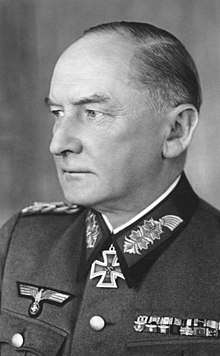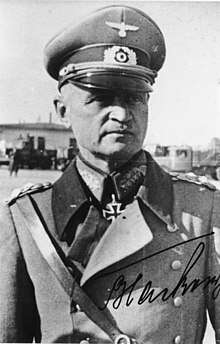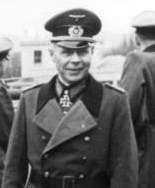1st Army (Wehrmacht)
The 1st Army (German: 1. Armee) was a World War II field army.
| 1. Armee 1st Army | |
|---|---|
| Active | 1939–1945 |
| Country | |
| Branch | Army |
| Type | Field army (Wehrmacht) |
| Engagements | World War II |
Combat chronicle
The 1st Army was activated on August 26, 1939, with General Erwin von Witzleben in command. Its primary mission was to guard the western defences of Germany against Allied forces along the Maginot Line, making it the principal adversary during the short-lived French Saar Offensive. During the battle of France, the army participated in the final breach of the line's defenses. After the French capitulation it spent until mid-1944 protecting the Atlantic coast of France from a possible seaborne incursion. Following the Normandy invasion in 1944, the army reorganized in Lorraine after a hasty retreat with the rest of the German forces across France in August 1944. During the battles along the German frontier, the First Army attempted to prevent the Third United States Army from crossing the Moselle River and capturing Metz while also attempting to hold the northern Vosges Mountains against the Seventh United States Army.
In November 1944, both defensive lines were broken and the First Army retreated to the German border and defended the Saarland of Germany, an important industrial region. With the Third U.S. Army engaged to the north against the German Ardennes Offensive, the 1st Army attacked the Seventh U.S. Army on New Year's Day 1945 in Operation Nordwind, causing the Americans to give ground and inflicting significant casualties where Seventh U.S. Army defensive lines were stretched taut by the length of frontage they had to cover. With the failure of Nordwind in late January, the 1st Army was first pushed back to the Siegfried Line and then forced to retreat across the Rhine River when the Allies pierced the German fortifications. Thereafter, the First Army made an ordered withdrawal to the Danube River before surrendering near the Alps on May 6, 1945.
Commanders
| No. | Commander | Took office | Left office | Time in office | |
|---|---|---|---|---|---|
| 1 | Generaloberst Erwin von Witzleben (1881–1944) | 26 August 1939 | 23 October 1940 | 1 year, 58 days | |
| 2 | Generaloberst Johannes Blaskowitz (1883–1948) | 24 October 1940 | 2 May 1944 | 3 years, 191 days | |
| 3 | General der Panzertruppe Joachim Lemelsen (1888–1954) | 3 May 1944 | 3 June 1944 | 31 days | |
| 4 | General der Infanterie Kurt von der Chevallerie (1891–1945) | 4 June 1944 | 5 September 1944 | 93 days | |
| 5 | General der Panzertruppe Otto von Knobelsdorff (1886–1966) | 6 September 1944 | 29 November 1944 | 84 days | |
| 6 | General der Infanterie Hans von Obstfelder (1886–1976) | 30 November 1944 | 2 February 1945 | 64 days | |
| 7 | General der Infanterie Hermann Foertsch (1895–1961) | 28 February 1945 | 4 May 1945 | 65 days | |
| 8 | General der Kavallerie Rudolf Koch-Erpach (1886–1971) | 6 May 1945 | 8 May 1945 | 2 days |
Chiefs of Staff
- Generalmajor Friedrich Mieth (26 May 1939 – 5 Feb 1940)
- Generalmajor Carl Hilpert (5 Feb 1940 – 25 Oct 1940)
- Oberst Edgar Röhricht (25 Oct 1940 – 16 June 1942; promoted to Generalmajor 1 Feb 1942)
- Generalmajor Anton-Reichard von Mauchenheim genannt Bechtolsheim (16 June 1942 – 1 Aug 1943)
- Oberst Gerhard Feyerabend (1 Aug 1943 – 10 Sep 1944; promoted to Generalmajor 1 Feb 1944)
- Oberst Willi Mantey (10 Sep 1944 – 7 Dec 1944)
- Oberst Walter Reinhard (7 Dec 1944 – 20 Feb 1945)
- Generalmajor Wolf Rüdiger Hauser (20 Feb 1945 – 8 May 1945)
Assignment and attachment to higher units
- 26 Aug 1939 Army Group C
- 27 Oct 1940 Army Group D
- 13 May 1944 Army Group G
- 12 Aug 1944 Army Group B
- 8 Sep 1944 Army Group G
Order of battle
| Subordinated units | |
|---|---|
| 1939 | |
| 9 Sep | IX Corps XXIV Corps XII Corps |
| 1940 | |
| 10 May | XII Corps XXIV Corps XXX Corps XXXVII Corps |
See also
- 1st Army (German Empire) for the equivalent formation in World War I
References
- Tessin, Georg (1965). Die Landstreitkräfte 1–5 [Ground Forces 1–5]. Die Verbände und Truppen der deutschen Wehrmacht und Waffen SS im Zweiten Weltkrieg 1939—1945 no. 2 (in German). Osnabrück: Biblio-Verl. pp. 1–4. OCLC 256594162.


.jpg)

